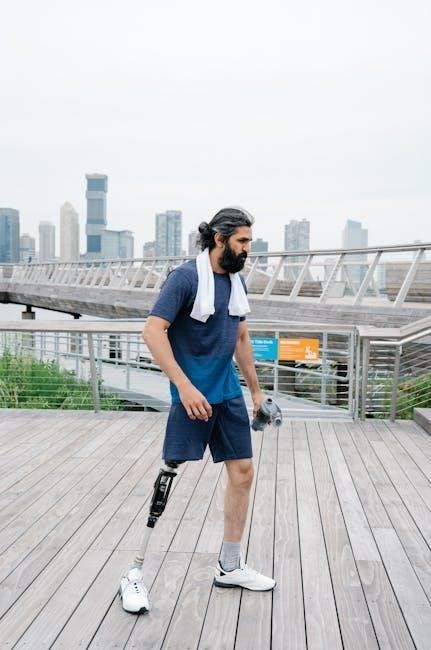A full body mobility routine enhances flexibility, joint health, and overall movement. It combines stretches, strength exercises, and techniques to improve range of motion and reduce stiffness. The PDF guide provides a structured plan with detailed exercises, videos, and tips for consistent practice, ensuring a comprehensive approach to achieving optimal mobility and wellness.
1.1 What is Full Body Mobility?
Full body mobility refers to the ability to move freely and efficiently across all joints and muscle groups. It combines dynamic stretches, joint mobilizations, and strengthening exercises to enhance flexibility, range of motion, and overall physical function. This practice targets every major area of the body, from the neck to the ankles, ensuring comprehensive movement improvement. By addressing both mobility and stability, it supports daily activities, athletic performance, and long-term joint health. A full body mobility routine is adaptable to all fitness levels and can be performed with or without equipment, making it accessible to everyone.
1.2 Why is Full Body Mobility Important?
Full body mobility is essential for maintaining optimal physical function and overall health. It improves joint health, enhances flexibility, and boosts range of motion, reducing the risk of injuries and chronic pain. Regular mobility practice promotes better posture, enhances athletic performance, and supports daily activities. By addressing stiffness and improving circulation, it increases energy levels and reduces muscle tension. Incorporating a full body mobility routine into your lifestyle is a proactive approach to preventing mobility loss and maintaining independence as you age. It’s a cornerstone for long-term wellness and active living.
1.3 Key Components of a Full Body Mobility Routine
A comprehensive full body mobility routine includes dynamic stretching, joint mobilization, and muscle activation exercises. It targets major areas like the neck, shoulders, hips, knees, and lower back. The routine incorporates tools such as foam rollers and resistance bands to enhance flexibility and strength. Each session typically starts with a warm-up to prepare the muscles and joints, followed by a series of movements that improve range of motion and reduce stiffness. Consistency and proper form are emphasized to ensure sustainable progress and overall physical well-being. The PDF guide offers a structured approach to implementing these elements effectively.
The Benefits of a Full Body Mobility Routine
A full body mobility routine improves joint health, enhances flexibility, and boosts energy levels. It reduces injury risk, promotes better posture, and supports overall physical well-being effectively.
2.1 Improved Joint Health and Range of Motion
A well-structured full body mobility routine focuses on enhancing joint health by increasing lubrication and reducing stiffness. Regular practice improves range of motion, allowing for smoother, more efficient movement. This not only supports daily activities but also boosts athletic performance. The PDF guide includes targeted exercises for each joint, ensuring comprehensive care. By incorporating these routines, individuals can maintain healthy joints and prevent degenerative conditions, promoting long-term mobility and flexibility.
2.2 Enhanced Flexibility and Muscle Strength
A full body mobility routine not only improves flexibility but also strengthens muscles, creating a balanced approach to physical fitness. By incorporating stretching and strengthening exercises, individuals can lengthen tight muscles while building resilience in weaker areas. The PDF guide offers a variety of movements that target major muscle groups, ensuring a holistic approach to enhancing both flexibility and strength. This combination reduces muscle imbalances and enhances overall athletic performance, making daily activities and workouts more efficient and injury-free. Consistency is key to achieving lasting results and maintaining optimal muscle function.
2.3 Better Posture and Reduced Risk of Injury
A full body mobility routine plays a crucial role in improving posture by strengthening core muscles and increasing flexibility. Poor posture often leads to misalignment, which can cause discomfort and injury. The PDF guide includes exercises that target key areas like the neck, shoulders, and lower back, helping to maintain proper alignment. Additionally, enhanced mobility reduces muscle tightness and joint stiffness, lowering the risk of injuries during physical activities. By incorporating these practices, individuals can enjoy better spinal alignment and a significantly reduced likelihood of experiencing strain or injury.
2.4 Increased Energy Levels and Overall Well-being
Engaging in a full body mobility routine can significantly boost energy levels and enhance overall well-being. By improving blood flow and reducing muscle tension, mobility exercises help combat fatigue and promote a sense of vitality. The PDF guide offers structured routines that incorporate dynamic stretches and foam rolling, which not only enhance physical mobility but also contribute to mental relaxation. Regular practice can lead to improved sleep quality, reduced stress, and a greater sense of overall wellness, making it an essential addition to a healthy lifestyle.

Warming Up for Full Body Mobility
A proper warm-up prepares the body for mobility exercises, enhancing circulation and flexibility while reducing injury risk. Dynamic stretches and joint mobilizations are key components, as detailed in the PDF guide.
3.1 Dynamic Stretching Exercises
Dynamic stretching involves active movements that warm up muscles and joints. These exercises, such as arm circles and leg swings, prepare the body for mobility routines by improving circulation and flexibility. The PDF guide includes detailed instructions and videos to ensure proper form. Regular practice enhances range of motion and reduces stiffness, making it an essential part of any pre-workout or daily routine. Incorporating dynamic stretches into your warm-up routine promotes better movement and sets the foundation for effective full-body mobility exercises.
3.2 Joint Mobilization Techniques
Joint mobilization techniques focus on improving joint health and range of motion through controlled movements. These exercises target specific joints, such as shoulders, hips, and knees, to reduce stiffness and enhance flexibility. Techniques may include gentle rotations, oscillations, or pressure applications. The PDF guide provides detailed step-by-step instructions and videos to ensure proper execution. Regular practice of these techniques can improve joint function, reduce pain, and prepare the body for more intense mobility routines. Incorporating joint mobilization into your daily routine promotes long-term joint health and overall mobility.
3.3 Muscle Activation and Preparation
Muscle activation and preparation are crucial for optimizing mobility routines. These exercises awaken dormant muscles, improving posture and movement efficiency. Techniques like isometric holds and dynamic movements prepare the body for physical activity, reducing injury risk. The PDF guide offers exercises targeting key muscle groups, ensuring proper activation and readiness. Regular practice enhances muscle strength, flexibility, and joint stability, laying a solid foundation for effective mobility training. By incorporating these techniques, individuals can achieve better alignment and performance in their daily routines and workouts.
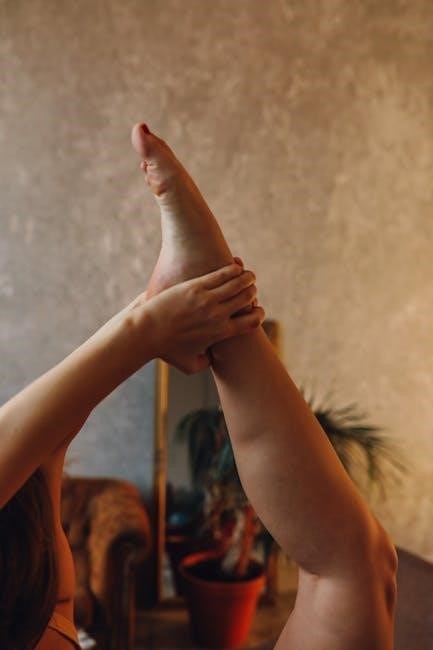
Upper Body Mobility Routine
This routine focuses on improving flexibility and mobility in the neck, shoulders, chest, and arms. Exercises include dynamic stretches and joint mobilizations to enhance range of motion and reduce stiffness, promoting better posture and overall upper body function. The PDF guide provides detailed steps and visuals for each exercise, ensuring a comprehensive approach to upper body mobility.
4.1 Neck and Shoulder Mobility Exercises
Neck and shoulder mobility exercises are essential for improving flexibility and reducing tension. Gentle rotations, lateral bends, and chin tucks target the cervical spine, while shoulder rolls and arm circles enhance shoulder joint mobility. Incorporating dynamic stretches and foam rolling can release tight muscles and improve posture. The PDF guide includes detailed steps for these exercises, ensuring proper form and maximum benefit. Regular practice helps alleviate stress and enhances overall upper body movement, making it a cornerstone of any effective mobility routine. These exercises are simple yet effective for maintaining healthy neck and shoulder function.
4.2 Chest and Shoulder Opening Stretches
Chest and shoulder opening stretches target tightness in the thoracic region and improve posture. Begin with a chest stretch by placing your hands on a door frame and leaning forward until you feel a gentle stretch. Shoulder blade squeezes and side stretches also enhance mobility. Use a resistance band or foam roller to deepen the stretches and release tension. These exercises are particularly beneficial for those with a desk-bound lifestyle, as they counteract hunched postures and promote better breathing. The PDF guide provides step-by-step instructions and variations to tailor the routine to your needs, ensuring effective and safe practice.
4.3 Wrist and Elbow Mobilization
Wrist and elbow mobilization exercises target stiffness and improve flexibility in these critical joints. Begin with wrist circles, rotating your wrists in both directions for 10-15 repetitions. Follow with wrist extensions and flexions, holding each stretch for 20-30 seconds. Elbow mobilization involves tricep stretches and forearm rotations to enhance range of motion. Incorporate resistance bands or light weights to deepen the stretches and strengthen the muscles around the joints. These exercises are particularly beneficial for individuals who engage in repetitive activities like typing or lifting. The PDF guide includes detailed instructions and variations to ensure safe and effective practice.
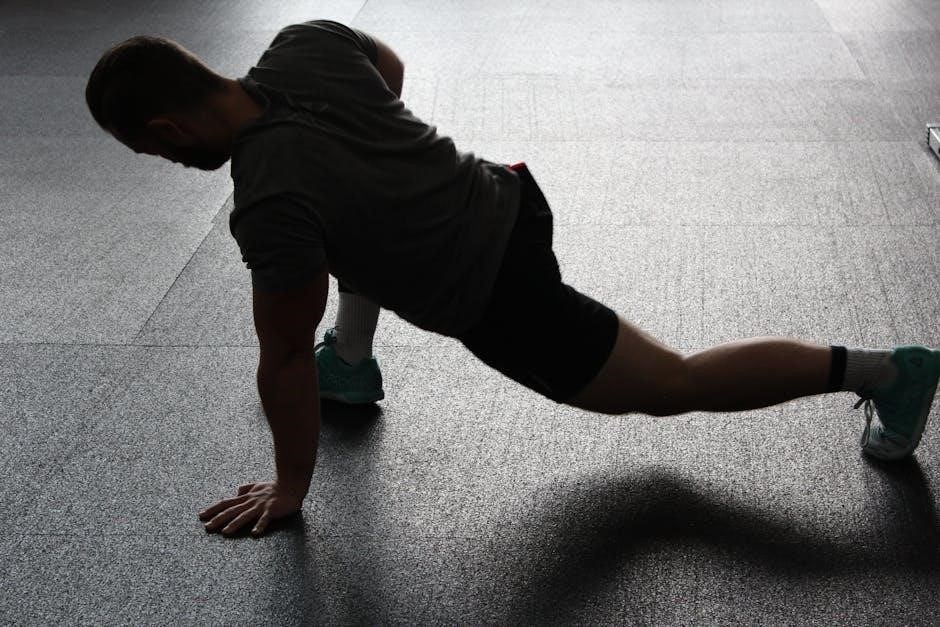
Lower Body Mobility Routine
Focus on improving flexibility and strength in hips, knees, and ankles. Techniques include dynamic stretches, lunges, and calf raises. Use foam rollers for muscle release. The PDF guide offers a structured plan for effective lower body mobility.
5.1 Hip and Pelvis Mobilization
Hip and pelvis mobilization is crucial for improving flexibility and reducing stiffness. Techniques include lunges, hip circles, and piriformis stretches. These exercises target tight muscles and enhance joint movement. The PDF guide provides detailed instructions and visuals for proper form. Regular practice can alleviate lower back pain and boost overall mobility. Incorporating tools like foam rollers can further release tension in the hip area. Consistency is key for long-term benefits and improved range of motion. Start with gentle movements and gradually increase intensity as flexibility improves.
5.2 Knee and Ankle Mobility Exercises
Knee and ankle mobility exercises are essential for maintaining healthy joints and preventing injuries. Simple movements like calf raises, ankle circles, and knee extensions can significantly improve flexibility. Incorporating resistance bands or light weights can enhance strength and stability. The PDF guide offers step-by-step instructions and visuals to ensure proper form. Consistency is key to achieving lasting benefits. Start with gentle repetitions and gradually increase intensity. These exercises are foundational for overall mobility and can be adapted to suit different fitness levels. Regular practice helps maintain joint health and supports active lifestyles.
5.3 Lower Back and Hamstring Stretches
Lower back and hamstring stretches are crucial for improving flexibility and reducing stiffness. Exercises like Forward Fold with Clasped Hands and Supine Hamstring Stretches target tight muscles. The PDF guide provides detailed instructions and visuals for these stretches, ensuring proper form. Incorporating tools like straps can enhance the depth of stretches. Regular practice helps alleviate lower back tension and improves posture. These exercises are gentle yet effective, making them suitable for all fitness levels. Consistency is key to achieving long-term flexibility and comfort in the lower back and hamstrings.

Enhancing Flexibility and Mobility
Enhance flexibility and mobility with targeted stretches and tools like foam rollers and resistance bands. These techniques improve range of motion and reduce muscle tension effectively.
6.1 Stretching Exercises for Major Muscle Groups
Targeted stretching exercises for major muscle groups like hamstrings, hips, chest, and shoulders improve flexibility and reduce stiffness. Incorporate forward folds, pyramid poses, and low lunges to enhance range of motion. Supine hamstring stretches and hip flexor releases are also effective. Use straps or resistance bands for deeper stretches. Active, loaded, and PNF contractions can further improve mobility. These exercises, detailed in the PDF guide, help maintain muscle balance and prevent injury, ensuring a comprehensive approach to full-body flexibility and strength.
6.2 Using Tools Like Foam Rollers and Resistance Bands
Foam rollers and resistance bands are essential tools for enhancing mobility. Foam rolling helps release muscle tension and improve circulation, while resistance bands provide gentle to intense stretching and strengthening. Use resistance bands for chest opens, shoulder stretches, and hip mobilization. Foam rollers are ideal for self-myofascial release on the IT band, quads, and lower back. These tools complement stretching exercises, offering a deeper release and improved flexibility. The PDF guide includes detailed techniques for incorporating these tools into your routine, ensuring maximum benefits for muscle recovery and joint health.
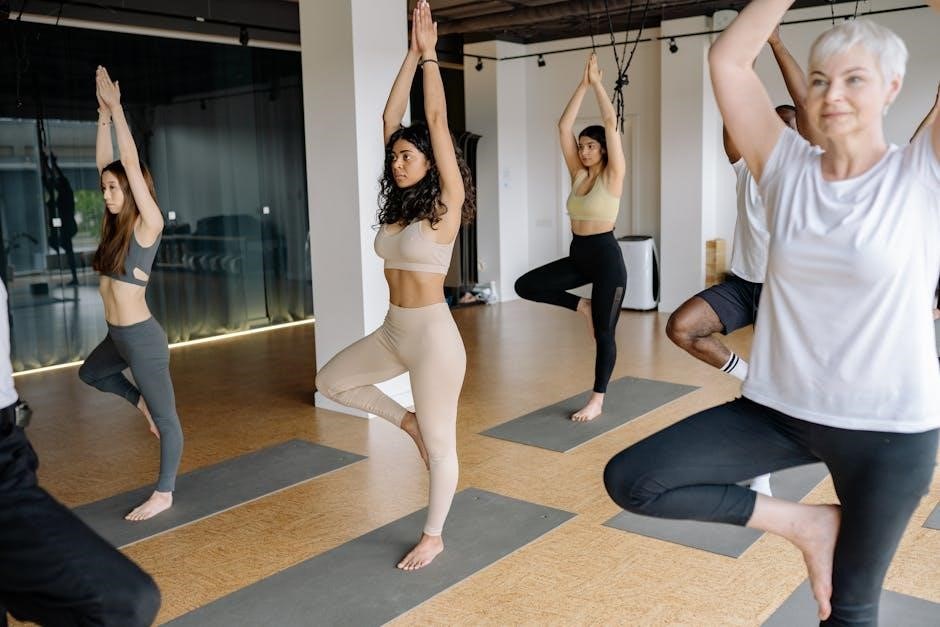
Full Body Mobility Routine for Recovery
A recovery-focused routine includes post-workout stretching and foam rolling to ease muscle tension. Active recovery techniques like gentle movements and breathing exercises promote relaxation and faster recovery. The PDF guide offers detailed instructions and follow-along videos for an effective recovery process.
7.1 Post-Workout Stretching and Foam Rolling
Post-workout stretching and foam rolling are essential for recovery, helping to reduce muscle soreness and improve circulation. Static stretches target major muscle groups, while foam rolling releases tension in the tissues. Dynamic stretches can also be incorporated to maintain flexibility and range of motion. The PDF guide includes detailed routines and videos to ensure proper technique and maximize recovery benefits.
Consistency is key to seeing results. Gentle movements and deep breathing during these exercises promote relaxation and faster recovery. The guide provides a structured approach to make recovery routines easy and effective.
7.2 Rest and Active Recovery Techniques
Rest and active recovery are vital for allowing your body to heal and adapt. Techniques include light cardio, yoga, and gentle mobilizations. These methods enhance blood flow and promote muscle repair without overexertion. The PDF guide offers structured active recovery routines, ensuring you maintain mobility while allowing your body to rest.
Active recovery can be tailored to individual needs, with options like swimming or cycling. Proper rest balances intense workouts, preventing burnout and injury. The guide provides tips to integrate rest and recovery effectively into your routine.
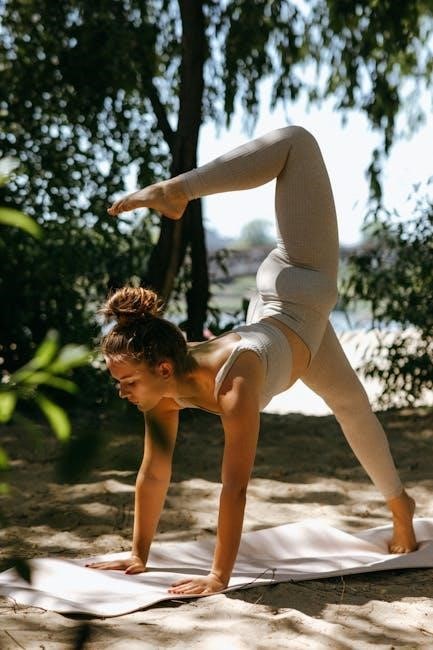
Structuring Your Full Body Mobility Routine
A well-structured full body mobility routine ensures balance and effectiveness. It covers major joints and movement patterns, with clear guidelines for consistency and progression, as outlined in the PDF guide.
8.1 Creating a Balanced and Effective Routine
A balanced full body mobility routine targets all major joints and muscle groups. The PDF guide offers a structured approach, combining dynamic stretches, joint mobilizations, and muscle activations. It emphasizes progression, allowing you to adapt exercises based on fitness levels. Consistency is key, with routines designed to fit various schedules. The guide also includes tips for warming up and cooling down, ensuring a holistic approach to mobility. By following this plan, you can enhance flexibility, strength, and overall well-being effectively.
8.2 Scheduling and Consistency Tips
Consistency is key to maximizing the benefits of a full body mobility routine. Aim to practice 3-4 times weekly, with sessions lasting 15-30 minutes. The PDF guide suggests starting with shorter routines and gradually increasing duration as mobility improves. Schedule sessions at the same time daily, such as first thing in the morning, to build a lasting habit. Tracking progress in the guide’s planner can help maintain motivation. Even small, consistent efforts yield significant improvements in flexibility and joint health over time.
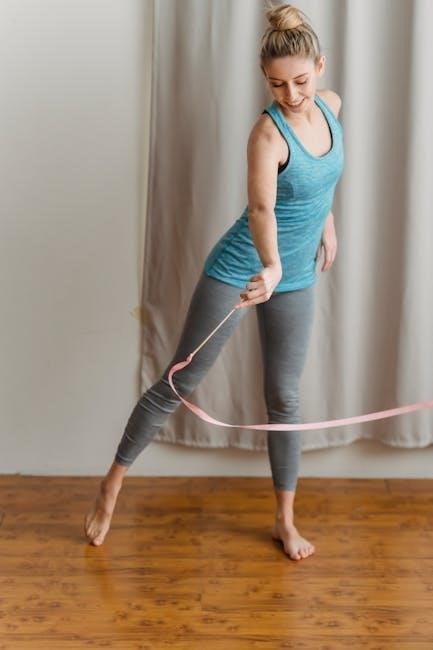
Full Body Mobility Routine PDF Guide
The Full Body Mobility Routine PDF offers a comprehensive, downloadable guide with detailed exercises, follow-along videos, and expert tips to enhance flexibility and joint health effectively;
9.1 Downloadable PDF Resources
The downloadable PDF resources provide a clear, structured plan for a full body mobility routine. Each guide includes step-by-step instructions, images, and tips to ensure proper form and progression. With exercises covering all major joints and muscle groups, these resources are ideal for both beginners and advanced individuals. The PDF format allows for easy access and offline use, making it convenient to follow the routine anywhere, anytime. Additionally, the resources often include variations and advanced techniques to keep the workouts engaging and effective over time.
9.2 Video Demonstrations and Follow-Along Guides
Complementing the PDF resources, video demonstrations provide visual guidance for each exercise in the full body mobility routine. These videos detail proper form, pacing, and breathing techniques, ensuring users perform movements safely and effectively. Follow-along guides offer real-time instruction, making it easier to stay on track and maintain consistency. By combining visual and audible cues, these resources enhance understanding and adherence to the routine. They are particularly useful for beginners or those who prefer learning through observation. The videos are often paired with the PDF for a comprehensive learning experience, allowing users to practice confidently anytime, anywhere.
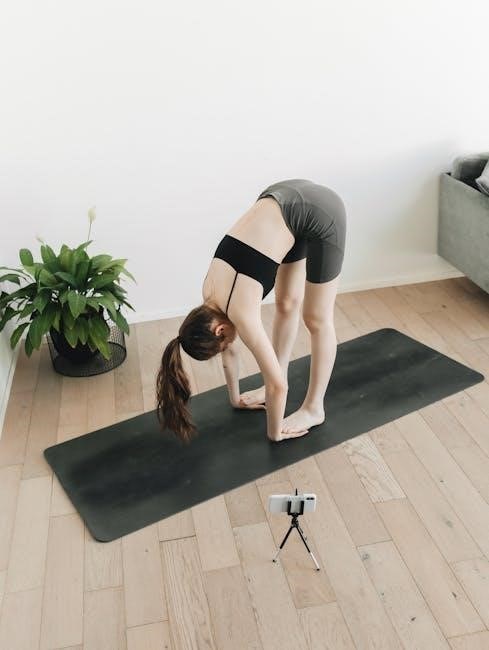
Progressing Your Full Body Mobility Routine
Advance your mobility routine with challenging exercises and dynamic movements. Incorporate tools like foam rollers and resistance bands for deeper stretches and strength gains. Use the PDF guide to explore advanced techniques and variations, ensuring continuous improvement and adaptation to your fitness level. Videos and follow-along guides provide clear instruction for mastering complex movements, helping you progress seamlessly and maintain long-term mobility.
10.1 Advanced Mobility Exercises and Techniques
Take your mobility routine to the next level with advanced exercises that target specific areas like hip mobilization and thoracic spine rotations. Techniques such as loaded stretches, PNF (proprioceptive neuromuscular facilitation), and dynamic joint movements can enhance flexibility and strength. Incorporate tools like resistance bands or foam rollers for deeper tissue activation. The PDF guide offers detailed instructions and videos to master these techniques safely and effectively. Focus on improving joint stability while increasing range of motion for better overall mobility and athletic performance. These exercises are designed to challenge your body and promote long-term flexibility and resilience.
10.2 Incorporating New Movements and Variations
Keep your mobility routine fresh and challenging by introducing new movements and variations. Explore advanced stretches like the “World’s Greatest Stretch” or incorporate dynamic exercises such as 90/90 hip stretches. Utilize tools like foam rollers and resistance bands to add variety and depth to your practice. The PDF guide includes follow-along videos and step-by-step instructions to help you master these techniques. By continuously evolving your routine, you can target different muscle groups and improve overall flexibility. This approach ensures long-term progress and keeps your workouts engaging and effective for full-body mobility.
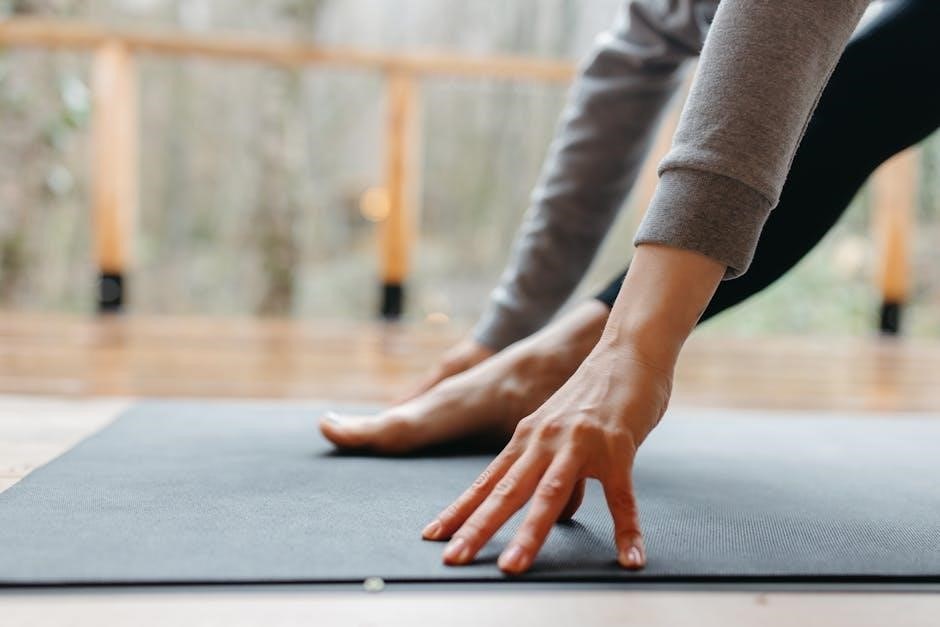
Common Mistakes to Avoid
Avoid overstretching and poor form, as they can lead to injury or reduced effectiveness. Neglecting key areas or inconsistent practice also hinders progress in your mobility routine.
11.1 Overstretching and Poor Form
Overstretching and poor form are common mistakes that can lead to injury or reduced effectiveness in your mobility routine. Avoid bouncing or forcing stretches beyond a comfortable range, as this can cause muscle strain or joint instability. Proper form ensures targeted areas are engaged safely. Listen to your body and adjust stretches based on flexibility levels. Using tools like videos from the PDF guide can help maintain correct technique. Neglecting form may lead to imbalanced mobility and prolonged discomfort. Focus on controlled, gradual movements to maximize benefits while minimizing risks.
11.2 Neglecting Key Areas and Movements
Neglecting key areas or movements in your mobility routine can lead to imbalances and reduced effectiveness. Failing to address major joints like the hips, shoulders, and lower back can result in poor posture or limited range of motion. Similarly, overlooking smaller areas like the ankles or wrists can hinder overall mobility. A PDF guide can help ensure a balanced routine by covering all essential movements. Consistency is key; skipping sections may lead to stiffness or injury over time. Always prioritize a comprehensive approach to maintain full-body flexibility and function.
Incorporating a full body mobility routine into your daily life can significantly enhance flexibility, strength, and overall well-being. With resources like a PDF guide and video tutorials, maintaining consistency is easier than ever. Prioritize mobility to prevent injuries and improve performance, ensuring a healthier, more active lifestyle for years to come. Start your journey today and experience the transformative benefits of full-body mobility.
12.1 Final Thoughts on Full Body Mobility
Embracing a full body mobility routine is a powerful investment in your long-term health and vitality. By dedicating just minutes daily to targeted stretches, joint mobilizations, and strengthening exercises, you can enhance flexibility, reduce stiffness, and improve overall movement. The PDF guide offers a clear, structured plan, while video demonstrations ensure proper form. Consistency is key to experiencing the profound benefits of mobility, from better posture and injury prevention to increased energy and a stronger connection to your body. Make mobility a priority and unlock a more active, pain-free life.
12.2 Encouragement to Start Your Routine
Starting your full body mobility routine is a simple yet impactful step toward better health. With just a few minutes daily, you can enhance flexibility, improve joint function, and boost energy. The PDF guide and video resources make it easy to follow along, ensuring proper form and progression. Remember, consistency is key—every small step adds up to significant long-term benefits. Take control of your mobility today and embrace a stronger, more active you. Your body will thank you for the investment in its health and well-being.
